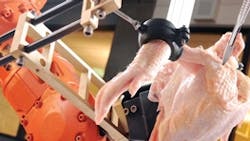Robotics, 3D vision simplify poultry deboning
Chicken deboning is one of the most unpleasant manual tasks faced by poultry workers, resulting in uneven meat yields and random bone chips in chicken breasts sold at grocery stores. Scientists at the Georgia Tech Research Institute (GTRI) hope to change all that. They have developed a prototype system that uses advanced imaging technology and a robotic cutting arm to automatically debone chicken and other poultry products. The Intelligent Cutting and Deboning System employs a 3D vision system, which determines where to cut a particular bird. The device automatically performs precision cuts that optimize yield and greatly reduce the risk of bone fragments.
“Each bird is unique in its size and shape,” says Gary McMurray, chief of GTRI's Food Processing Technology Division. “So we have developed the sensing and actuation needed to allow an automated deboning system to adapt to the individual bird, as opposed to forcing the bird to conform to the machine.”
Poultry is Georgia's top agricultural product, with an estimated annual economic impact of nearly $20 billion. Helping the poultry industry maximize its return on every flock boosts the local economy, which is why the state of Georgia is funding the research.
With the prototype, a bird is positioned in front of the vision system prior to making a cut, explains GTRI research engineer Michael Matthews. The vision system works by making 3D measurements of various points on the bird's exterior. Using these points as inputs, custom algorithms define a proper cut by estimating the positions of internal structures such as bones and ligaments.
“Statistics research shows that our external measurements correlate very well to the internal structure of the birds, and therefore will transition to ideal cutting paths,” says Matthews. “In our prototype device, everything is registered to calibrated reference frames, allowing us to handle all cut geometries and to precisely align the bird and the cutting robot. The ability to test all possible cut geometries should enable us to design a smaller and more simplified final system.”
The prototype uses a fixed two-DOF cutting robot for making simple planar cuts. The bird is mounted on a six-DOF robot arm that allows alignment of the bird and cutting robot to any desired position. The robot arm places the bird under the vision system, and then it moves the bird with respect to the cutting robot. The system employs a force-feedback algorithm that can detect the transition from meat to bone, says research engineer Ai-Ping Hu. That detection capability allows the cutting knife to move along the surface of the bone while maintaining a constant force.
Because ligaments are attached to bone, maintaining contact with the bone allows the knife to cut all the ligaments around the shoulder joint without cutting into the bone itself. A similar approach can be used for other parts of the bird where meat must be separated from bone.
Hu explains that the force-feedback algorithm uses a force sensor affixed to the knife handle. During a cutting operation, the sensor enables the robot to detect imminent contact with a bone. Then, instead of cutting straight through the bone, the system directs the cutting tool to take an appropriate detour.
“Fine tuning is needed to adjust the force thresholds, to be able to tell the difference between meat, tendon, ligaments and bone, each of which have different material properties,” Hu notes.
McMurray says he expects the Intelligent Deboning System to match or exceed the efficiency of the manual process. Testing of the deboning prototype system, including cutting experiments, has confirmed the system's ability to recognize bone during a cut and to avoid bone chips, thus demonstrating the validity of GTRI's approach.
“There are some major factors at play in this project,” McMurray says. “Our automated deboning technology can promote food safety, because bone chips are a hazard in boneless breast fillets. But it can also increase yield, which is significant because every 1% loss of breast meat represents about $2.5 million to each of Georgia's 20 poultry processing plants.”
For more information, visit gtri.gatech.edu.
